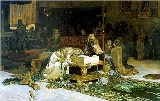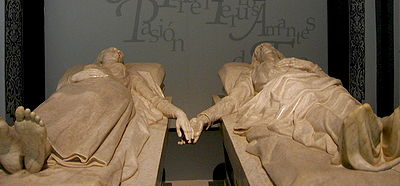
Lovers of Teruel
Encyclopedia

Spanish language
Spanish , also known as Castilian , is a Romance language in the Ibero-Romance group that evolved from several languages and dialects in central-northern Iberia around the 9th century and gradually spread with the expansion of the Kingdom of Castile into central and southern Iberia during the...
Los amantes de Teruel) is a romance story that is alleged to have taken place in 1217 in the city of Teruel
Teruel
Teruel is a town in Aragon, eastern Spain, and the capital of Teruel Province. It has a population of 34,240 in 2006 making it one of the least populated provincial capitals in the country...
(Aragón
Aragon
Aragon is a modern autonomous community in Spain, coextensive with the medieval Kingdom of Aragon. Located in northeastern Spain, the Aragonese autonomous community comprises three provinces : Huesca, Zaragoza, and Teruel. Its capital is Zaragoza...
).
In the city there were two important and wealthy families, Marcilla and Segura. Juan Martinez (also known as Diego) was a Marcilla and Isabel a Segura. The two were in love as childhood playmates but when they were both at an eligible age to wed, Diego's family had fallen on hard times. Isabel's father, being the most wealthy in all of Teruel, forbade the marriage. Diego, however, was able to make an agreement with the father in which he would leave Teruel for five years to try to build his fortune. If Diego was able to gain wealth within those five years he would be able to marry his love, Isabel.
During those five years her father pestered her to marry someone. She replied to him by saying that God wished her to remain a virgin until she turned twenty, saying that women should learn how to manage the household before getting married. Because her father loved her dearly and wished for her happiness he agreed, and for five years they waited for Diego's return.
Diego was not heard from in those five years and so on the day of the five years' close Isabel's father married her to Don Pedro de Azagra from Albarracín
Albarracín
Albarracín is Spanish town, in the province of Teruel, part of the autonomous community of Aragon. According to the 2007 census , the municipality had a population of 1075 inhabitants...
. Right after the wedding ceremony there was a commotion at the Zaragoza gate. The watchmen informed the village that Diego Marcilla had returned with great riches and with the intent of marrying Isabel. Diego had not counted the day in which he petitioned Isabel's father whereas the Seguras had.
That night, Diego sneaked into the bedroom of Isabel and her husband and gently awoke her. He pleaded to her, "Besame, que me muero," (Kiss me for I am dying) and she refused, saying "No quiera Dios que yo falte a mi marido," (God would not wish me to deceive my husband) "Por la pasion de Jesucristo os suplico que busques a otra, que de mi no hagais cuenta. Pues si a Dios no ha complacido, tampoco me complace a mi." (For the love of Christ, I beg you to find another, and forget about me. If our love could not please God, then neither should it please me.)
He begged her one last time, saying that he was dying and wished for a final kiss. But still she refused. Upon hearing this Diego could not bear the separation between himself and his love, and with a sigh he died on the feet of his beloved Isabel. When she realized that he died, she shivered. She woke her husband, telling him that his snoring scared her and she wished to hear a story. And he did, and in return she told him her own story. She told him of Diego and how he lay dead beside the bed.
"Oh, you wretched! Why did you not kiss him?"
"To not deceive my husband." She replied.
"Of course," he groaned. "You are a woman worthy of praise."
They agreed on secretly burying him in the local church because the husband feared that he would be blamed for his death. The next day, during the funeral for Diego Marcilla, Isabel showed up dressed in her wedding dress. She proceeded to walk to the front of the church and place a kiss on the man whom she had refused but in doing so Isabel died, falling prostrate on the body of the man whom she loved.
History
The two deaths caused by love inspired the citizens of TeruelTeruel
Teruel is a town in Aragon, eastern Spain, and the capital of Teruel Province. It has a population of 34,240 in 2006 making it one of the least populated provincial capitals in the country...
and they demanded that the two be buried side by side so that at least in death they could be together. This request was granted by the church. The fame of the couple soon spread through Spain
Spain
Spain , officially the Kingdom of Spain languages]] under the European Charter for Regional or Minority Languages. In each of these, Spain's official name is as follows:;;;;;;), is a country and member state of the European Union located in southwestern Europe on the Iberian Peninsula...
and in 1560 their mummies were exhumed and placed in the tombs where they now rest.
Controversy
Many scholars have debated the authenticity of the Lovers of Teruel. Their reason is that in 1353 the Italian BoccaccioGiovanni Boccaccio
Giovanni Boccaccio was an Italian author and poet, a friend, student, and correspondent of Petrarch, an important Renaissance humanist and the author of a number of notable works including the Decameron, On Famous Women, and his poetry in the Italian vernacular...
told practically the same tale under the name Girolamo e Salvestra, although he had some additional material in his story. In Boccaccio's version the erotic is stressed in the additional material. Logically, it is more likely that the erotic version came second; it is difficult to find instances in which popular taste borrowed an erotic tale from a professional writer, sanitised it and then claimed it to be a traditional folk tale. It is unlikely that the simple folk of Teruel borrow a naughty take from Boccaccio and cleaned it up in their retelling; whereas it would be reasonable to say that a professional and sophisticated writer of Boccaccio's skill could borrow a sentimental folk tale emanating from Teruel and introduce the erotic elements in his version. Therefore it seems much more likely that it was Boccaccio who did the borrowing.Throughout history, other cultures have had similar tales of forbidden love, such as Hero and Leander
Hero and Leander
Hero and Leander is a Byzantine myth, relating the story of Hērō and like "hero" in English), a priestess of Aphrodite who dwelt in a tower in Sestos on the European side of the Dardanelles, and Leander , a young man from Abydos on the opposite side of the strait. Leander fell in love with Hero...
and Romeo and Juliet
Romeo and Juliet
Romeo and Juliet is a tragedy written early in the career of playwright William Shakespeare about two young star-crossed lovers whose deaths ultimately unite their feuding families. It was among Shakespeare's most popular archetypal stories of young, teenage lovers.Romeo and Juliet belongs to a...
.
The Tombs of the Lovers

Spain
Spain , officially the Kingdom of Spain languages]] under the European Charter for Regional or Minority Languages. In each of these, Spain's official name is as follows:;;;;;;), is a country and member state of the European Union located in southwestern Europe on the Iberian Peninsula...
to see the Lovers of Teruel, the mummies were exhumed and put into two new tombs that were sculpted by Juan de Ávalos
Juan de Ávalos
Juan de Ávalos y García-Taborda was a Spanish sculptor....
. The tombs are carved out of marble and bear the family shields of Marcilla and Segura, but the most attractive part of the tombs are the lids. The lids are exquisitely carved: one features the strong and handsome Diego, his one arm outstretched, reaching for his love Isabel – his hand comes close to touching her, but because of religious piety they do not touch (since Isabel was married). The lid for Isabel is radiant and most beautiful.
According to 'professor' Antonio Beltrán, the legend grew when two mummies were found in San Peter’s Church (Teruel
Teruel
Teruel is a town in Aragon, eastern Spain, and the capital of Teruel Province. It has a population of 34,240 in 2006 making it one of the least populated provincial capitals in the country...
, Aragón
Aragon
Aragon is a modern autonomous community in Spain, coextensive with the medieval Kingdom of Aragon. Located in northeastern Spain, the Aragonese autonomous community comprises three provinces : Huesca, Zaragoza, and Teruel. Its capital is Zaragoza...
, Spain), in 1555; and it was believed that they were Diego Marcilla and Isabel Segura, the lovers.

